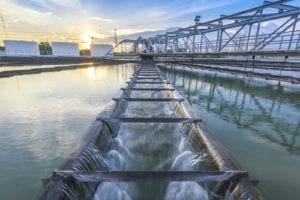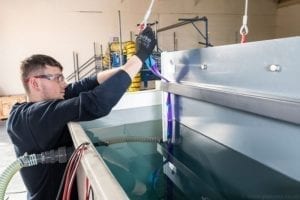As compliance deadlines loom for industrial surfactant contamination in wastewater, engineers must turn their eyes to new treatment methods
Surfactants, because of their specific features, are in ubiquitous use in households as detergents or personal-care products and in various industries: pesticides, chemicals, textiles and pharmaceuticals. The use of detergents in industry and beyond is virtually universal. Apart from their applications in keeping our homes, hospitals and workplaces clean and sanitary, they are also used to maintain the highest possible hygienic standards in laboratory research, quality control and manufacturing, not least in the pharmaceutical, life science and food sectors.
Due to their efficiency and widespread use in almost every industry, surfactants are common pollutants in municipal and industrial wastewaters (Figure 1), and depending on their chemical makeup, some surfactants can pose complex water-treatment challenges, especially those chemicals that are known to be environmentally toxic.

FIGURE 1. Scientific advances in the detection of specific contaminants in wastewater streams make it possible to easily identify the presence of toxins in minute quantities
Scientific advances in the detection of specific contaminants in wastewater streams make it possible to easily identify the presence of such toxic contaminants in minute quantities and proportions. Once discovered, there are new technologies available capable of removing them virtually entirely — and thus avoiding both social consequences and compliance breaches that might occur in the event of a discharge.
Surfactants
Surfactants fall into three main categories: anionic, cationic and non-ionic, with the anionic group comprising around 50% of all surfactants used globally and the non-ionic variety accounting for around 45%. They are often used together, as the non-ionic ones do not interact with ions in hard water, or if very high-purity solutions are needed. Furthermore, the qualities of the non-ionic surfactants — being better emulsifiers and producing less foam — make them the preferred choice for industrial use.
However, it has been confirmed by research that generally non-ionic surfactants (at lethal concentrations depending on various tests from 0.0025 to 300 mg/L) are more toxic than others (anionic: 0.3 to 200 mg/L) [1]
Due to their higher toxicity and widespread use, it is important to pay special attention to non-ionic surfactants and make efforts to prevent their intrusion into water systems.
Perhaps the most common non-ionic surfactant in use in industry is octylphenol ethoxylate, typically marketed under the name Triton X-100 (TX-100), but it is also available under a variety of other brand names around the world.
Regulatory concerns
Due to its potential endocrine disrupting properties, Triton X-100 is listed as a contaminant of emerging concern (CEC). Its degradation products — 4-octylphenol in particular — are also ecotoxic. Posing a serious environmental and health hazard and in the face of a dramatic escalation in the contaminant landscape, regulators are doing their best to keep the public safe. Their response has been to increase the frequency of testing and analysis, the introduction of stricter controls and constant vigilance. On March 23, 2017, the European Parliament ratified the REACH vote to place Triton X-100 onto Annex XIV of the REACH regulations. This means that it cannot be used or placed on the market after the “sunset date,” which is to be January 4, 2021.
After this date, products containing chemicals from the family of Triton cannot be used in the E.U., unless authorization was granted by the authorities or the intended use is exempted from authorization.
Development of a surfactant with the same qualities of Triton X-100 that is not damaging to the environment and is safe to use will be a long, complicated process. Industries are faced with the problem that use of Triton X-100 is to be banned in a years’ time, while suitable replacements are hard to find and usually involve a compromise in some aspect of the product’s performance.
Industries that cannot find a replacement will be compelled to apply for an exemption to continue to use it. Proof of its effective destruction from effluent may lead to authorization being given for its continued use, even following the regulatory deadline. This regulatory amend has encouraged users of TX-100 to investigate options to fully remove it from wastewater to prevent its release into the sewer or aquatic environment.
Although the European Chemicals Agency (ECHA) does not specify a set limit for TX-100 in effluent, each facility must apply for permissions and are given different targets based on factors including their location, flowrate of effluent and other water quality parameters. However, some facilities may be permitted higher limits until the substance is banned. Although there is still confusion as to what can be expected in terms of regulation around removing TX-100, organizations who use the substance should be preparing now to find an alternative to TX-100.
With the threat of mandatory regulatory compliance on the visible horizon, it would be an appropriate time for chemical engineers to examine the most appropriate treatment options (Figure 2). Apart from the unpleasant professional implications of being forced into compliance by paying fines and having other disruptive penalties imposed, in a wider business context, corporate reputation must also be considered.

FIGURE 2. Engineers must evaluate the best water-treatment options for surfactant contamination, as the deadline for meeting mandatory compliance requirements looms
Treatment challenges
TX-100 consists of a hydrophilic head group and a hydrophobic tail in order to facilitate the emulsification of oils and organic soils. Additionally, as a non-ionic surfactant, it is thought to be less irritating to the skin, increasing its wide adoption into household and personal cleaning products.
Its use extends beyond being a key component of most household and industrial cleaners. It is also instrumental in the manufacture of paints and coatings, pulp and paper processing, oil extraction, textiles, agrochemicals and metalworking fluids. Triton X-100‘s extensive use relies on its excellent properties as a detergent and wetting agent, its effectiveness as a dispersant and emulsifier for oil in water systems and its effective performance across a broad temperature range, unlike other non-ionic surfactants, which precipitate out of solution at higher temperatures. What is less well-known is that non-ionic surfactant chemicals are also active ingredients in quite a number of end products.
Pollutants, such as alkyl phenyl polyethoxylated-type non-ionic surfactants, like Triton X-100, are suspected to be endocrine disrupters in aquatic organisms. These pollutants make their way into the natural environment through sewage treatment works, where they are not always removed completely.
As Triton forms dangerous breakdown products and is toxic to biological systems, the options for its treatment are quite limited. Furthermore, it is a clear viscous liquid that is soluble in water, making its removal from the water matrix even more difficult. Some companies are using advanced oxidation processing (AOP) methods, such as ultraviolet (UV) oxidation, in order to increase pollutants’ biodegradability and allow for it to be discharged into an on-site wastewater treatment plant (WWTP). Another viable treatment strategy is to remove the waste altogether by incinerating it, because it is not easily removed by biological treatment methods. However, incineration poses its own environmental concerns associated with CO2 emissions from trucking and burning.
Most management teams responsible for wastewater treatment now agree that the thermal oxidation process, which involves contaminated water being collected and trucked off to a third-party specialist facility is an expensive option, with negative environmental implications. This has led many organizations to seek out more sustainable on-site wastewater decontamination alternatives (Figure 3).

FIGURE 3. Modular, onsite wastewater-treatment units can be an effective option for streams that are laden with difficult-to-treat surfactants
Some research has shown that Triton X-100 is biodegradable under both anaerobic and aerobic conditions. However, the biodegradability is limited to the types of organisms used in the treatment and the initial feed concentrations of the compound. Due to the Triton inhibitory effect, the biodegradability potential of anaerobic sludge and the Vibrio cyclitrophicus bacterium are limited at Triton concentrations of 31.6 and 562.5 mg/L respectively. These concentrations are much lower than some industrial effluents, which can reach concentrations of up to 10 g/L.
The benefits of removing contaminants on-site can include continuous re-use of expensive water, zero sludge to remove, complete traceability of hazardous waste for audit purposes and complete compliance with upcoming legislation. Additionally, by treating problematic wastewater on-site, the cost of discharging the water to a WWTP is also avoided.
A hybrid treatment method, such as one that combines adsorption with electrochemical oxidation, can achieve conditions where organic contamination is preferentially adsorbed and fully mineralized to H₂O, H₂ and CO2. There are no sludge effluents, the electrical current simultaneously regenerates the surface of the media in-situ and oxidizes the organics, allowing for further adsorption and treatment without interruption. The treatment is chemical-free and does not generate any sludge. The complete oxidation of the detergent allows for the discharge of the water directly to sewer or enables its reuse in the industrial process. ♦
Edited by Mary Page Bailey
References
- Czech, B., and Wiesława C., Advanced Oxidation Processes in Triton X-100 and Wash-up Liquid Removal from Wastewater Using Modified TiO2/Al2O3 Photocatalysts, Water, Air, and Soil Pollution, 223,8, 2012.
Author

Akmez Nabeerasool is head of projects, service and delivery at Arvia Technology (Runcorn, Cheshire, U.K. WA7 4EB; E-mail: [email protected]). He has over 10 years’ experience managing multi-site and multi-disciplinary projects spanning from water to nuclear waste treatment delivering projects to meet strict performance, timelines and cost targets. He has vast expertise in managing technology development and innovation through effective IP management, commercial assessment and market adoptability of novel technologies and concepts, managing a wide team and provide rapid solutions to pressing issues.